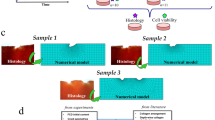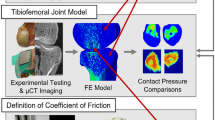Abstract
Osteoarthritis has become a major disease threatening human health. The mechanism of injury under fluid involvement can be studied by finite element method. However, most models only model the articular cartilage to study the subchondral bone structure, which is too simplistic. In this study, a complete osteochondral unit was modeled and provided with a poroelastic material, and as osteoarthritis develops and the size, thickness, and shape of the osteochondral unit defect varies, the fluid flow behavior is altered, which may have functional consequences that feed back into the progression of the injury. The results of the study showed that interstitial fluid pressure and velocity decreased in defective osteochondral units. This trend was exacerbated as the size and thickness of the defect in the osteochondral unit increased. When the defect reached the trabeculae, pressure around the cartilage defect in the osteochondral unit was greatest, flow velocity in the subchondral cortical bone was greatest, and pressure and flow velocity around the trabecular defect were lowest. As osteoarthritis develops, the osteochondral unit becomes more permeable, and the pressure of the interstitial fluid decreases while the flow rate increases, resulting in severe nutrient loss. This may be the fluid flow mechanism behind osteochondral defects and osteoarthritis.
Graphical Abstract












Similar content being viewed by others
References
Hubert J, Beil FT, Rolvien T, Butscheidt S, Hischke S, Puschel K, Frosch S, Mussawy H, Ries C, Hawellek T (2020) Cartilage calcification is associated with histological degeneration of the knee joint: a highly prevalent, age-independent systemic process. Osteoarthritis Cartilage 28:1351–1361
Lories RJ, Luyten FP (2011) The bone-cartilage unit in osteoarthritis. Nat Rev Rheumatol 7:43–49
Liu H-Y, Duan H-T, Zhang C-Q, Wang W (2017) Study of the mechanical environment of chondrocytes in articular cartilage defects repaired area under cyclic compressive loading. J Healthc Eng 2017:1–10
Manda K, Eriksson A (2014) Modeling of constrained articular cartilage growth in an intact knee with focal knee resurfacing metal implant. Biomech Model Mechanobiol 13:599–613
Castaneda S, Roman-Blas JA, Largo R, Herrero-Beaumont G (2012) Subchondral bone as a key target for osteoarthritis treatment. Biochem Pharmacol 83:315–323
Goldring MB, Goldring SR (2010) Articular cartilage and subchondral bone in the pathogenesis of osteoarthritis. Ann N Y Acad Sci 1192:230–237
Holopainen JT, Brama PA, Halmesmaki E, Harjula T, Tuukkanen J, van Weeren PR, Helminen HJ, Hyttinen MM (2008) Changes in subchondral bone mineral density and collagen matrix organization in growing horses. Bone 43:1108–1114
Ansari S, Khorshidi S, Karkhaneh A (2019) Engineering of gradient osteochondral tissue: From nature to lab. Acta Biomater 87:41–54
Hislop BD, Heveran CM, June RK (2021) Development and analytical validation of a finite element model of fluid transport through osteochondral tissue. J Biomech 123:110497
Sajjadinia SS, Haghpanahi M, Razi M (2019) Computational simulation of the multiphasic degeneration of the bone-cartilage unit during osteoarthritis via indentation and unconfined compression tests. Proc Inst Mech Eng H 233:871–882
Stender ME, Regueiro RA, Ferguson VL (2017) A poroelastic finite element model of the bone-cartilage unit to determine the effects of changes in permeability with osteoarthritis. Comput Methods Biomech Biomed Engin 20:319–331
Hunziker EB, Lippuner K, Keel MJ, Shintani N (2015) An educational review of cartilage repair: precepts & practice–myths & misconceptions–progress & prospects. Osteoarthritis Cartilage 23:334–350
Nukavarapu SP, Dorcemus DL (2013) Osteochondral tissue engineering: current strategies and challenges. Biotechnol Adv 31:706–721
Orava H, Huang L, Ojanen SP, Makela JTA, Finnila MAJ, Saarakkala S, Herzog W, Korhonen RK, Toyras J, Tanska P (2022) Changes in subchondral bone structure and mechanical properties do not substantially affect cartilage mechanical responses - A finite element study. J Mech Behav Biomed Mater 128:105129
Madry H, van Dijk CN, Mueller-Gerbl M (2010) The basic science of the subchondral bone. Knee Surg Sports Traumatol Arthrosc 18:419–433
Liao J, Tian T, Shi S, Xie X, Ma Q, Li G, Lin Y (2017) The fabrication of biomimetic biphasic CAN-PAC hydrogel with a seamless interfacial layer applied in osteochondral defect repair. Bone Res 5:17018
Nerem RM, Alexander RW, Chappell DC, Medford RM, Varner SE, Robert Taylor W (1998) The study of the influence of flow on vascular endothelial biology. Am J Med Sci 316:169–175
Sun Y, Wang N, Yu J, Yan Y, Dong H, Wu X, Zhang M, Wang Y, Li P, Wei X, Chen W (2021) Study on the poroelastic behaviors of the defected articular cartilage. Comput Methods Biomech Biomed Engin 25:1288–1300
Alford JW, Cole BJ (2005) Cartilage restoration, part 2: techniques, outcomes, and future directions. Am J Sports Med 33:443–460
Lin Y, Qin J, Zhao H, Xia C (2020) Construction and analysis of finite element model of defected articular cartilage. Saudi J Biol Sci 27:556–560
Men Y-t, Li X-m, Yang N, Wang X, Zhang C-q (2018) Analysis of the mechanical effects of defect shape on damage evolution of articular cartilage under rolling load. Mater Sci Eng C 92:407–415
Sah RL, Yang AS, Chen AC, Hant JJ, Halili RB, Yoshioka M, Amiel D, Coutts RD (1997) Physical properties of rabbit articular cartilage after transection of the anterior cruciate ligament. J Orthop Res 15:197–203
Pragnere S, Boulocher C, Pollet O, Bosser C, Levillain A, Cruel M, Hoc T (2018) Mechanical alterations of the bone-cartilage unit in a rabbit model of early osteoarthrosis. J Mech Behav Biomed Mater 83:1–8
Kabir W, Di Bella C, Choong PFM, O’Connell CD (2021) Assessment of native human articular cartilage: a biomechanical protocol. Cartilage 13:427S-437S
Ebacher V, Tang C, McKay H, Oxland TR, Guy P, Wang R (2007) Strain redistribution and cracking behavior of human bone during bending. Bone 40:1265–1275
Hwang J, Bae WC, Shieu W, Lewis CW, Bugbee WD, Sah RL (2008) Increased hydraulic conductance of human articular cartilage and subchondral bone plate with progression of osteoarthritis. Arthritis Rheum 58:3831–3842
Funding
This work was supported by the Regional Joint Key Funding Program of the National Natural Science Foundation of China (Grant No. U21A20353), the National Natural Science Foundation of China (Grant Nos. 12272250, 11972242, and 82172503), China Postdoctoral Science Foundation (Grant No. 2020M680913), Shanxi Province Returned Overseas Foundation (Grant No. 2022–081), the Shanxi Province Basic Research Program (Grant No. 202203021212254), and the Graduate Innovation Program of Shanxi Province (Grant No. 2023–125).
Author information
Authors and Affiliations
Corresponding authors
Ethics declarations
Competing interests
The authors declare no competing interests.
Additional information
Publisher's Note
Springer Nature remains neutral with regard to jurisdictional claims in published maps and institutional affiliations.
Rights and permissions
Springer Nature or its licensor (e.g. a society or other partner) holds exclusive rights to this article under a publishing agreement with the author(s) or other rightsholder(s); author self-archiving of the accepted manuscript version of this article is solely governed by the terms of such publishing agreement and applicable law.
About this article
Cite this article
Zhong, H., Lou, X., Fan, X. et al. Study on the poroelastic behaviors of the defected osteochondral unit. Med Biol Eng Comput 62, 1139–1152 (2024). https://doi.org/10.1007/s11517-023-02996-8
Received:
Accepted:
Published:
Issue Date:
DOI: https://doi.org/10.1007/s11517-023-02996-8




